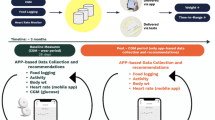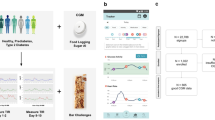ABSTRACT
Self-monitoring is an effective strategy for chronic disease management; many readily available mobile applications allow tracking of diabetes-related health behaviors but their use has not yet been integrated into routine clinical care. How patients engage with these applications in the real world is not well understood. The specific aim of this study is to survey adults with type 2 diabetes (T2D) regarding self-monitoring behaviors, including mobile application use. In 2015, we surveyed an adult diabetes clinic population (n = 96) regarding self-monitoring behaviors: diet, physical activity, weight, and blood glucose. Self-monitoring with any method ranged from 20–90 %. About half of the participants owned smartphones; few had mobile applications. The most common app-tracked behavior was physical activity, then weight and diet. Despite numerous available mobile health-tracking applications, few T2D adults from our sample used them, though many reported self-monitoring with other methods.
Similar content being viewed by others
References
World Health Organization. Definition, diagnosis and classification of diabetes mellitus and its complications. Part 1: diagnosis and classification of diabetes mellitus. 1999.
Mata-Cases, M., De Prado-Lacueva, C., Salido-Valencia, V., et al. (2011). Incidence of complications and mortality in a type 2 diabetes patient cohort study followed up from diagnosis in a primary healthcare centre. Int J Clin Pract, 65(3), 299–307. doi:10.1111/j.1742-1241.2010.02503.x.
Stratton, I. M., Adler, A. I., Neil, H. A. W., et al. (2000). Association of glycaemia with macrovascular and microvascular complications of type 2 diabetes (UKPDS 35): prospective observational study. Br Med J, 321(7258), 405–412.
Centers for Disease Control and Prevention. National Diabetes Statistics Report, 2014. http://www.cdc.gov/diabetes/data/statistics/2014StatisticsReport.html. Published 2014. Accessed 2 Sept 2014
Skyler, J. S. (2004). Effects of glycemic control on diabetes complications and on the prevention of diabetes. Clin Diabetes, 22(4), 162–166. doi:10.2337/diaclin.22.4.162.
Hirsch, I. B., Bode, B. W., Childs, B. P., et al. (2008). Self-monitoring of blood glucose (SMBG) in insulin- and non–insulin-using adults with diabetes: consensus recommendations for improving SMBG accuracy, utilization, and research. Diabetes Technol Ther, 10(6), 419–439.
Sarol, J. N., Nicodemus, N. A., Tan, K. M., & Grava, M. B. (2005). Self-monitoring of blood glucose as part of a multi-component therapy among non-insulin requiring type 2 diabetes patients: a meta-analysis (1966–2004). Curr Med Res Opin, 21(2), 173–183.
Butryn, M. L., Phelan, S., Hill, J. O., & Wing, R. R. (2007). Consistent self-monitoring of weight: a key component of successful weight loss maintenance. Obesity, 15(12), 3091–3096. doi:10.1038/oby.2007.368.
Wing, R. R., Tate, D. F., Gorin, A. A., Raynor, H. A., & Fava, J. L. (2006). A self-regulation program for maintenance of weight loss. N Engl J Med, 355(15), 1563–1571. doi:10.1056/NEJMoa061883.
VanWormer, J. J., Martinez, A. M., Martinson, B. C., et al. (2009). Self-weighing promotes weight loss for obese adults. Am J Prev Med, 36(1), 70–73. doi:10.1016/j.amepre.2008.09.022.
VanWormer, J. J., Linde, J. A., Harnack, L. J., Stovitz, S. D., & Jeffery, R. W. (2011). Self-weighing frequency is associated with weight gain prevention over 2 years among working adults. Int J Behav Med, 19(3), 351–358. doi:10.1007/s12529-011-9178-1.
Klem, M. L., Wing, R. R., McGuire, M. T., Seagle, H. M., & Hill, J. O. (1997). A descriptive study of individuals successful at long-term maintenance of substantial weight loss. Am J Clin Nutr, 66(2), 239–246.
Karter, A. J., Ackerson, L. M., Darbinian, J. A., et al. (2001). Self-monitoring of blood glucose levels and glycemic control: the Northern California Kaiser Permanente Diabetes registry. Am J Med, 111(1), 1–9. doi:10.1016/S0002-9343(01)00742-2.
Breland, J. Y., McAndrew, L. M., Burns, E., Leventhal, E. A., & Leventhal, H. (2013). Using the common sense model of self-regulation to review the effects of self-monitoring of blood glucose on glycemic control for non–insulin-treated adults with type 2 diabetes. Diabetes Educ, 39(4), 541–559. doi:10.1177/0145721713490079.
Polonsky, W. H., Fisher, L., Schikman, C. H., et al. (2011). Structured self-monitoring of blood glucose significantly reduces A1C levels in poorly controlled, noninsulin-treated type 2 diabetes results from the Structured Testing Program study. Diabetes Care, 34(2), 262–267. doi:10.2337/dc10-1732.
Hsu, W. C., Lau, K. H. K., Huang, R., et al. (2015). Utilization of a cloud-based diabetes management program for insulin initiation and titration enables collaborative decision making between healthcare providers and patients. Diabetes Technol Ther. doi:10.1089/dia.2015.0160.
Lim, S., Kang, S. M., Shin, H., et al. (2011). Improved glycemic control without hypoglycemia in elderly diabetic patients using the ubiquitous healthcare service, a new medical information system. Diabetes Care, 34(2), 308–313. doi:10.2337/dc10-1447.
Fox S, Duggan M. Mobile Health. Pew Internet Research Project. 2012. http://wwwpewinternetorg/2012/11/08/mobile-health-2012/ Published November 8, 2012.
Mulvaney, S. A., Ritterband, L. M., & Bosslet, L. (2011). Mobile intervention design in diabetes: review and recommendations. Curr Diab Rep, 11(6), 486–493. doi:10.1007/s11892-011-0230-y.
Liang, X., Wang, Q., Yang, X., et al. (2011). Effect of mobile phone intervention for diabetes on glycaemic control: a meta-analysis. Diabet Med, 28(4), 455–463. doi:10.1111/j.1464-5491.2010.03180.x.
Breland, J. Y., Yeh, V. M., & Yu, J. (2013). Adherence to evidence-based guidelines among diabetes self-management apps. Transl Behav Med, 3(3), 277–286. doi:10.1007/s13142-013-0205-4.
Chomutare, T., Fernandez-Luque, L., Årsand, E., & Hartvigsen, G. (2011). Features of mobile diabetes applications: review of the literature and analysis of current applications compared against evidence-based guidelines. J Med Internet Res, 13(3), e65. doi:10.2196/jmir.1874.
Anderson M. Technology Device Ownership: 2015. Pew Research Center. http://www.pewinternet.org/2015/10/29/technology-device-ownership-2015/. Published October 9, 2015.
AARP: Project Catalyst. Building a better tracker: older consumers weigh in on activity and sleep monitoring devices. 2015. http://www.aarp.org/about-aarp/press-center/info-07-2015/activity-sleep-trackers-show-promise-for-improving-health-for-older-consumers.html.
Lim S, Kang SM, Kim KM, et al. Multifactorial intervention in diabetes care using real-time monitoring and tailored feedback in type 2 diabetes. Acta Diabetol. 2015, 1–10. doi:10.1007/s00592-015-0754-8.
Free, C., Phillips, G., Galli, L., et al. (2013). The effectiveness of mobile-health technology-based health behaviour change or disease management interventions for health care consumers: a systematic review. PLoS Med, 10(1), e1001362. doi:10.1371/journal.pmed.1001362.
IMS Institute for Healthcare Informatics. Patient apps for improved healthcare: from novelty to mainstream. IMS Health. 2013. http://www.imshealth.com/en/thought-leadership/ims-institute/reports/patient-apps-for-improved-healthcare#ims-form. Published October 2013
Ahn D. Why it’s such a big deal that mainstream glucometers are going wireless. MedGadget. 2015. http://www.medgadget.com/2015/12/why-its-such-a-big-deal-that-mainstream-glucose-meters-are-going-wireless.html. Published December 23, 2015.
Author information
Authors and Affiliations
Corresponding author
Ethics declarations
Funding
This project was funded by an internal grant from the Brown University Clinical Psychology Training Consortium.
Conflict of interest
The authors declare that they have no conflict of interest.
Additional information
Implications
Practice: Diabetes care providers and mobile application developers have key roles to play in ensuring that applications meet evidence-based clinical recommendations, and in narrowing the gap between application availability and real-world use among adults with type 2 diabetes.
Policy: Greater emphasis should be placed on user-friendly applications that adhere to evidence-based clinical guidelines and integrate with diabetes healthcare delivery (e.g., transmitting blood glucose meter readings without need for human data entry).
Research: More research in clinical settings is needed to determine how best to implement mobile application tracking for adults with type 2 diabetes, and to identify which health behaviors and outcomes are most beneficial for this population to self-monitor.
About this article
Cite this article
Tanenbaum, M.L., Bhatt, H.B., Thomas, V.A. et al. Use of self-monitoring tools in a clinic sample of adults with type 2 diabetes. Behav. Med. Pract. Policy Res. 7, 358–363 (2017). https://doi.org/10.1007/s13142-016-0418-4
Published:
Issue Date:
DOI: https://doi.org/10.1007/s13142-016-0418-4




